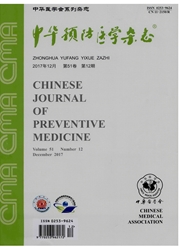

 中文摘要:
中文摘要:
目的 探索全球高致病性禽流感(highly pathogenic avian influenza,HPAI)H5N1疫情的空间分布特征,识别高风险聚集区,为禽流感疫情监测、发展趋势提供科学依据。方法 收集和整理世界动物卫生组织和粮农组织疫情监测报告中的2004年1月~2009年12月间的HPAIH5N1疫情,运用空间扫描统计量和空间聚类方法分析全球HPAIH5N1的空间分布。结果 空间扫描统计量分析显示疫情呈现非随机分布的特征,在空间分布上存在聚集性,共检测出15个高风险聚集区,主要集中在中欧、南欧、非洲东北部地区以及亚洲的东南部地区。空间聚类分析显示高风险聚集区主要集中于欧洲的德国、法国、瑞士和意大利,以及亚洲的东南部地区。结论 全球HPAI H5N1呈现空间聚集分布,高风险聚集区主要位于中欧、南欧以及东南亚,为重点监控区域。候鸟迁徙可能是跨洲远距离传播的重要途径。
 英文摘要:
英文摘要:
Objective To explore the spatial distribution characteristics and identify high risk clusters, so as to provide scientific evidence for epidemic surveillance and trends of avian influenza H5N1. Methods HSN1 outbreak repor- ted to World Organization for Animal Health (OIE) and the Food and Agriculture Organization (FAO) of the UN from Jan- uary 2004 to December 2009 were collected. Spatial scan statistics and spatial clustering analysis were used to analyze the spatial distribution of HPAI H5N1. Results Spatial scan statistics showed that the epidemic distribution was non-random. 15 high risk clusters were detected, which were mainly concentrated in Central and Southern Europe, the Northeast of Afri- ca, and the Southeast of Asia. Spatial clustering analysis showed that high risk clusters were mainly concentrated in Germa- ny, France, Switzerland, Italy, and Southeast Asia region. Conclusions Clustering of HSN1 outbreaks was confirmed in this study, and high risk clusters were mainly concentrated in the Central and Southern Europe and the Southeast of Asia, where enhanced surveillance should be conducted. Birds migration may play a key role in HSNI spreading across continents over a long distance.
 同期刊论文项目
同期刊论文项目
 同项目期刊论文
同项目期刊论文
 Spatio-Temporal Patterns of Schistosomiasis Japonica in Lake and Marshland Areas in China: The Effec
Spatio-Temporal Patterns of Schistosomiasis Japonica in Lake and Marshland Areas in China: The Effec Human infections andco-infections with helminths in a rural population in Guichi, Anhui Province,Chi
Human infections andco-infections with helminths in a rural population in Guichi, Anhui Province,Chi Identifying Spatial Clusters of Schistosomiasis in Anhui Province of China: A Study from the Perspec
Identifying Spatial Clusters of Schistosomiasis in Anhui Province of China: A Study from the Perspec Spatio-temporal Transmission and Environmental Determinants of Schistosomiasis Japonica in Anhui Pro
Spatio-temporal Transmission and Environmental Determinants of Schistosomiasis Japonica in Anhui Pro Transmissibility of the highly pathogenic avian influenza virus (HAPIV) subtype H5N1 in domestic pou
Transmissibility of the highly pathogenic avian influenza virus (HAPIV) subtype H5N1 in domestic pou Dynamics of spatial clustering of schistosomiasis in the Yangtze River Valley at the end of and foll
Dynamics of spatial clustering of schistosomiasis in the Yangtze River Valley at the end of and foll Identification of Parasite-Host Habitats in Anxiang County, Hunan Province, China Based on Multi-Tem
Identification of Parasite-Host Habitats in Anxiang County, Hunan Province, China Based on Multi-Tem Long-Term Impact of the World Bank Loan Project for Schistosomiasis Control: A Comparison of the Spa
Long-Term Impact of the World Bank Loan Project for Schistosomiasis Control: A Comparison of the Spa Spatial comparison of schistosomiasis risk regions in the hilly and mountainous regions of China: an
Spatial comparison of schistosomiasis risk regions in the hilly and mountainous regions of China: an Evolutionary characteristics of A/Hangzhou/1/2013 and source of avian influenza virus H7N9 subtype i
Evolutionary characteristics of A/Hangzhou/1/2013 and source of avian influenza virus H7N9 subtype i Identification of high-risk regions for schistosomiasis in the Guichi region of China: an adaptive k
Identification of high-risk regions for schistosomiasis in the Guichi region of China: an adaptive k 期刊信息
期刊信息
